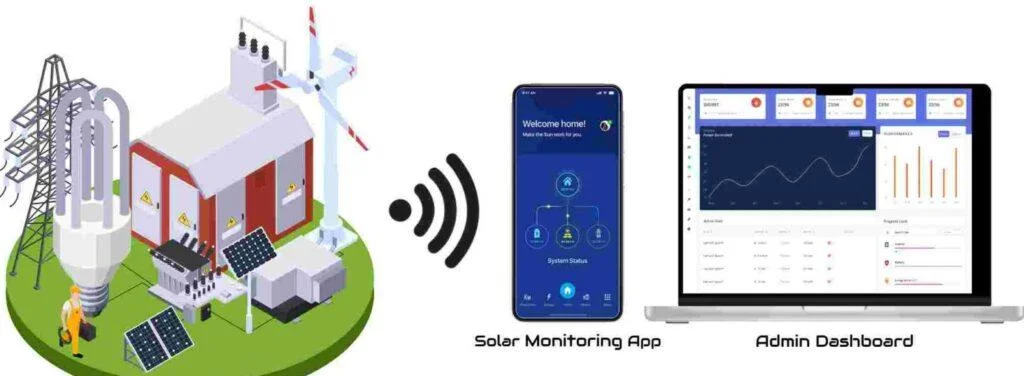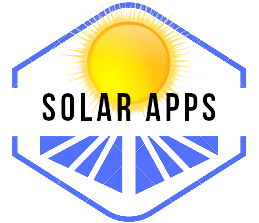Solar monitoring app explore the finest solar monitoring apps available and assess their compatibility with your specific solar panels. Congratulations on the successful installation of your new solar panel system! Renewable energy to meet your household’s needs, so now well-positioned to generate. However, have you considered the possibility of unknowingly wasting a significant amount of energy? Are you making the most efficient use of the energy produced by your solar panels?
This is where a solar monitoring app becomes indispensable. This remarkable innovation holds immense potential for the future of solar energy generation. Recognize the significance of data. With a solar monitoring app, solar customers access comprehensive data about their energy systems. This app generates valuable insights that allow you to optimize the utilization of your solar energy. Without further delay, let’s delve deeper into this unique technology within the energy sector.

Contents
A Glimpse into Solar Monitoring Apps
Solar monitoring systems are digital tools designed to provide real-time insights and data analytics related to solar panel systems. Through these apps, users gain an in-depth understanding of how their solar panels are performing, how much energy they’re generating, and how efficiently they’re functioning. This information empowers users to make informed decisions to optimize energy usage, system maintenance, and even financial planning.
What is the purpose of a solar monitoring app?
The primary purpose of a solar monitoring app is to provide. Real-time information and insights regarding the performance of your photovoltaic system. This application enables you to stay updated on energy consumption and generation. It empowers you to optimize energy usage and address any issues that may impact the efficiency of your solar system.
Efficient monitoring and maintenance are crucial for maximizing the effectiveness of your solar panels and related systems. Imagine a scenario where you have multiple appliances, ranging from small to large, connected to your solar panels. How would you determine which devices consume the most or least energy? By utilizing a solar monitoring app, you can easily track energy consumption and make well-informed decisions. This includes the ability to turn off appliances that are not in use, reducing overall energy usage.
How does a solar monitoring app work?
Solar monitoring systems gather data from the inverter connected to the solar panels. Many companies offer solar inverters with built-in monitoring software. The role of the solar inverter is to convert the direct current (DC) generated by the panels. And into alternating current (AC) for household use. The inverter collects information about power levels and production and then transmits it to cloud-based power monitoring systems and companion applications. Homeowners can access this information through various means, such as mobile apps and compatible smart devices. Monitoring systems can also provide on-site monitoring capabilities by connecting. The inverter’s data to a power monitoring device within your home.
They are allowing direct access to cloud-stored data from your mobile devices without relying on Wi-Fi networks. Some monitoring apps are paired with solar power systems equipped with cellular capabilities. Even without an internet connection, you can still access data through solar monitoring apps. Systems with advanced power optimizers can transmit data independently of wireless connections, ensuring uninterrupted monitoring even during internet outages.
Advantages
Solar monitoring apps offer numerous advantages, particularly in terms of improving system maintenance. Let’s delve into some of the key benefits:
Enhanced System Operations Awareness:
With a solar monitoring app, users gain a comprehensive understanding of their solar system’s performance and operations. Real-time data and insights enable better decision-making and optimization.
Email Updates & Alerts:
The app keeps users informed with timely email updates and alerts. These notifications can range from system performance updates to potential issues or maintenance requirements, ensuring prompt attention to any concerns.
Data on the Go:
No longer confined to a specific location, access to solar system data is now possible from anywhere. The monitoring app allows users to conveniently access vital information on their mobile devices, enabling remote monitoring and management.
Harnessing the capabilities of a solar monitoring app is. The users can proactively maintain their systems, maximize efficiency, and stay informed about their solar energy production at all times.
Best solar monitoring apps
Now that we have acquainted ourselves with the basics of app system monitoring which are solar connect apps, let’s delve into the top-rated options currently on the market. This solar app was downloaded by:
- SolarEdge Monitoring App
- Solar Power Monitor App
- MySolarEdge App
- SolarCT – Solar PV Calculator
- ESolar Air App
- Enphase Enlighten App
- SolarEdge Inverter SetApp
The Features that Illuminate
Solar monitoring apps come equipped with a range of features that offer a comprehensive view of solar panel systems:
- Real-time Energy Generation: These apps provide up-to-the-minute data on the amount of energy being generated by solar panels. Users can observe the impact of varying weather conditions, time of day, and other factors on energy production.
- Energy Consumption Tracking: Many apps allow users to monitor their energy consumption alongside energy production. This insight enables users to align their energy usage with peak production times, maximizing self-consumption and reducing reliance on the grid.
- Historical Data Analysis: Solar monitoring apps store historical data, enabling users to analyze energy trends over days, weeks, months, or even years. This data can aid in understanding seasonal variations and long-term system performance.
- Remote Monitoring: With remote access capabilities, users can monitor their solar panel systems from anywhere using a smartphone or tablet. This is particularly valuable for those who want to stay connected while on the go.
- Alerts and Notifications: Apps can send notifications for important events, such as sudden drops in energy production or system malfunctions. Timely alerts enable users to address issues promptly and prevent prolonged inefficiencies.
- Energy Savings Suggestions: Some advanced apps provide insights into energy-saving opportunities based on historical data and energy usage patterns. These suggestions can guide users in making informed decisions about energy consumption habits.
The Benefits of Solar Monitoring Apps
The adoption of solar monitoring apps brings forth an array of benefits that amplify the value of solar panel systems:
- Optimized Energy Management: By analyzing real-time and historical data, users can adjust their energy consumption behaviors to align with peak energy production, reducing reliance on grid power.
- Improved Efficiency: These apps empower users to detect and address system inefficiencies promptly. The ability to identify underperforming panels or equipment ensures optimal energy production.
- Cost Savings: With insights into energy consumption patterns, users can minimize grid consumption during high-tariff periods, resulting in substantial cost savings over time.
- Remote Troubleshooting: Remote monitoring allows users to diagnose and troubleshoot issues without physically accessing the solar panels. This can save time and resources in maintenance.
- Enhanced Sustainability: By maximizing the efficiency of solar panel systems, users contribute to reducing their carbon footprint and minimizing their environmental impact.
Best Solar Monitoring System
In an era marked by the increasing adoption of renewable energy sources, solar power stands as a prominent contender for a sustainable future. As solar installations become more common, the importance of efficient monitoring systems cannot be understated. A reliable solar monitoring system is the key to understanding the performance of your solar panels, optimizing energy consumption, and ensuring the longevity of your investment. In this article, we delve into the world of solar monitoring systems, review some of the best options available, and ultimately crown the one that stands out as the best.
Importance of Solar Monitoring: Monitoring your solar energy system’s performance is like having a virtual window into its operation. By tracking factors such as energy production, consumption patterns, and potential issues, you can take proactive measures to maintain optimal performance. Additionally, real-time data empowers you to make informed decisions about energy usage, leading to potential savings and a smaller carbon footprint.
Review of Top Solar Monitoring Systems:
- SolarEdge Monitoring System:
- Features: SolarEdge offers a comprehensive monitoring platform that provides real-time visibility into your solar system’s performance. It showcases energy production, and consumption, and even provides remote troubleshooting capabilities.
- Pros: User-friendly interface, detailed data insights, system health alerts, and historical performance tracking.
- Cons: Some advanced features might require technical familiarity.
- Enphase Enlighten:
- Features: Enphase’s monitoring system focuses on individual microinverters, providing granular insights into panel-level performance. It offers an intuitive app and web interface.
- Pros: Panel-level monitoring, advanced analytics, user-friendly app, proactive issue detection.
- Cons: Primarily suited for Enphase microinverter systems.
- SMA Sunny Portal:
- Features: SMA offers a monitoring solution for both residential and commercial systems. It provides real-time data, detailed reports, and remote diagnostics.
- Pros: Versatility for different system sizes, robust reporting, remote troubleshooting.
- Cons: Interface can be complex for newcomers.
- Sense Solar Monitoring:
- Features: Sense takes a holistic approach, monitoring overall home energy consumption while distinguishing between solar and grid energy sources.
- Pros: Whole-home energy monitoring, accurate tracking of energy sources, device-level insights.
- Cons: Less focused on solar system-specific performance.
- Solaredge and Enphase Compared:
- A head-to-head comparison between the SolarEdge and Enphase systems, considering factors such as monitoring granularity, ease of use, and compatibility with different system types.
Crowning the Champion: The Best Solar Monitoring System:
Selecting the best solar monitoring system depends on individual preferences, system size, and desired level of detail. While all the reviewed systems have their merits, SolarEdge’s comprehensive monitoring platform edges out the competition. Its user-friendly interface, in-depth data insights, and system health alerts make it an excellent choice for both residential and commercial installations. Enphase Enlighten comes in a close second, particularly for those with microinverter systems.
A Step into the Future
As technology continues to advance, solar monitoring apps are poised to become even more sophisticated and user-friendly. Integration with smart home systems, artificial intelligence-driven predictive analytics, and seamless integration with energy storage solutions are just a few of the developments on the horizon.
Solar monitoring apps have transformed the way we interact with solar energy systems. They empower users with the information needed to make informed decisions, reduce energy consumption, and maximize the benefits of solar power. As renewable energy adoption grows, these apps will play a crucial role in shaping a more sustainable, efficient, and interconnected energy landscape.
